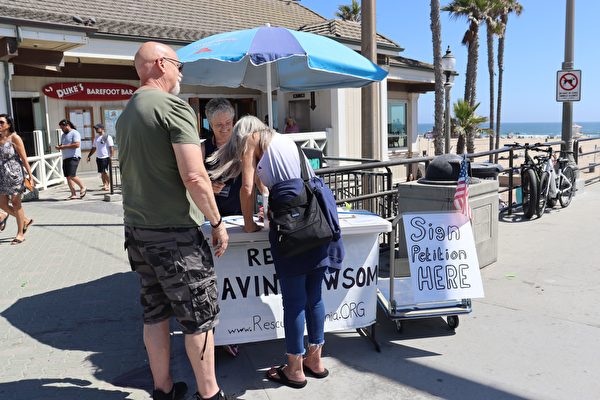On June 15, volunteers in Huntington Beach City gathered signatures for the petition to recall Governor Gavin Newsom. This marks the second recall effort the governor has faced since he won re-election at the end of 2022.
According to the Secretary of State’s office, the new recall petition was approved on March 26 and must be submitted by September 3 (within 160 days). The minimum number of valid signatures required is 1,311,963, which is equivalent to 12% of the votes cast in the most recent gubernatorial election.
Volunteer Lisa stated, “We need to collect 1.6 million signatures because some signatures may be invalidated due to errors, so we aim to gather around 20% more by September.” Lisa, who has volunteered for the Newsom recall effort for the third time, mentioned previous challenges faced with insufficient signatures.
In March 2021, the “Recall Newsom” grassroots organization submitted over 2.16 million signatures, with nearly 1.72 million deemed valid, reaching a validation rate of 79.58%. Despite Governor Newsom receiving 61.9% support in the September 2021 recall election, it ultimately failed. In the November 2022 midterm election, Newsom garnered around 6.47 million votes with a 59.2% approval rating.
Lisa, who had been collecting signatures elsewhere the day before, emphasized the diverse origin of signatories on the busy pier, ranging from Orange County residents to voters from Los Angeles, Kern, Riverside, and San Bernardino counties.
From late 2021 to mid-2022, banners and signature collection points for the Newsom recall could be seen prominently in many cities in Southern California. However, Lisa noted a decrease in volunteers and funding this year due to the pandemic period when people had more time to engage compared to the current busier schedules.
While stationed at the booth, the reporter observed a mix of passersby signing the petition and others showing disinterest. One signer expressed skepticism, suggesting the effort might be a “waste of time.”
Expressing her attachment to California, Lisa remarked, “California makes me sad. I was born and raised here, I love California, I don’t want to leave, so I will do my best to try to make a difference.”
The grounds for the Newsom recall cited by the grassroots organization include California having the highest tax rates, cost of living, crime rates, debt levels, insurance premiums, homeless population, poor education, and low job growth rate.
The organization further criticized Newsom for prioritizing national issues over California, resulting in a $68 billion budget deficit and crises in public safety, immigration, and education. It highlighted the allocation of $3 billion annually for healthcare services to 700,000 illegal immigrants at the expense of essential programs for veterans, schoolchildren, the disabled, and the homeless.
According to CalMatter, Newsom’s spokesperson Nathan Click commented during the approval of the recall petition in March that Democrats nationwide, especially those in California, viewed the recall effort as a partisan power grab by the Republican Party.
Governor Newsom’s revised budget proposal in May projected a $56 billion debt for California in the next two fiscal years. Lisa emphasized the wide-ranging impact of the debt issue on individuals and future generations, motivating not only adults but also newly registered young voters to sign the petition.
Volunteer Debbie, conducting signature collection under the sun, mentioned her involvement in the Newsom recall effort for the third time. She remarked on the widespread discontent with California’s situation, with many signatories this time having also participated in the previous recall effort, indicating no need for further explanation.
In the 2021 recall attempt, Newsom raised over $70 million from donors to combat the recall, while the grassroots recall organization collected $8 million. However, this year, it appears that both sides have struggled to raise significant funds.

